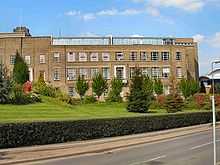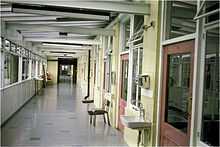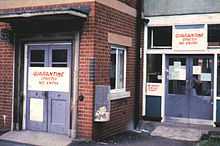Janet Parker

Janet Parker (March 1938[1] – 11 September 1978) was a British medical photographer who became the last person to die from smallpox. She was exposed to the virus as a result of a laboratory accident at the University of Birmingham Medical School.[2][3] Parker worked as a medical photographer in the Anatomy Department, where she was accidentally exposed to a strain of smallpox virus that was grown in a research laboratory on the floor below. Her death led to the suicide of the then Head of the Microbiology Department.
An official government inquiry into Parker's death was led by microbiologist R.A. Shooter,[4] whose report was debated in the British Parliament.[5] The conclusion that the virus was most likely spread from the smallpox laboratory through ducting was challenged in court when the University was prosecuted by the Health and Safety Executive for breach of Health and Safety legislation. The prosecution failed. Expert evidence, presented by the defence and accepted by the magistrates, showed that sufficient virus material could not be produced by the laboratory to generate an infectious dose in the room where Parker was supposedly infected.[6] Although the source of infection was traced the mode of transmission was not. Parker's death triggered radical changes in how dangerous pathogens were studied in the UK.[7][8]
Background

Smallpox is an infectious disease unique to humans, caused by either of two virus variants named Variola major and Variola minor.[9] The last naturally occurring infection was of Variola minor in Somalia in 1977.[10]
The laboratory at Birmingham was conducting research on variants of smallpox virus known as "whitepox viruses",[11] which were considered to be a threat to the success of the World Health Organisation's smallpox eradication programme.[12]
Death

At the time of her death, Parker lived in Burford Park Road, Kings Norton, Birmingham, UK, and was employed at the University of Birmingham Medical School. She often worked in a darkroom above a laboratory where research on live smallpox viruses was being conducted. The viruses probably spread through a service duct that connected the two floors.[2] On 11 August 1978, Parker (who had been vaccinated against smallpox in 1966[13]) fell ill; she had a headache and pains in her muscles. She developed spots that were thought to be a benign rash. Parker was admitted to East Birmingham (now Heartlands) Hospital on 24 August and a clinical diagnosis was made of Variola major, the most serious type of smallpox (by Professor Alasdair Geddes and Dr. Thomas Henry Flewett). The next day, poxvirus infection was confirmed by electron microscopy of vesicle fluid. Janet Parker was transferred to Catherine-de-Barnes, (then an isolation hospital) where she died of smallpox on 11 September 1978. Many people had close contact with Parker before she was admitted, but only her mother contracted the disease. Parker's mother, Hilda Witcomb (née Linscott) [1] survived, but her father, Frederick Witcomb, died aged 77 following a cardiac arrest when visiting Parker in the hospital.[14] The other close contacts, which included two Biomedical Scientists, from the Birmingham Regional Virus Laboratory based at East Birmingham Hospital, were released from quarantine in Catherine-de-Barnes on 10 October 1978.[15]

On 6 September 1978, Professor Henry Bedson, the son of Sir Samuel Phillips[16] and the head of the medical microbiology department, committed suicide. He cut his throat in the garden shed at his home and died at the Queen Elizabeth Hospital in Birmingham a few days later. His suicide note read "I am sorry to have misplaced the trust which so many of my friends and colleagues have placed in me and my work."[17] In 1977, the World Health Organisation (WHO) had told Henry Bedson that his application for his laboratory to become a Smallpox Collaborating Centre had been rejected. This was partly because of safety concerns; the WHO wanted as few laboratories as possible handling the virus.[18]
Over a year later, in October 1979, the university authorities fumigated the Medical School East Wing.[15]
A similar outbreak occurred in 1966, when Tony McLennan, who was also a medical photographer and worked in the same laboratory later used by Janet Parker, contracted smallpox. He had a milder form of the disease, which was not diagnosed for eight weeks.[15] He was not quarantined and there were at least twelve further cases in the West Midlands.[19]
Shooter report

Official publication of the Report of the investigation into the cause of the 1978 Birmingham smallpox occurrence (Shooter report) in 1980 noted that Bedson failed to inform the authorities of changes in his research that could have affected safety. Shooter discovered that the Dangerous Pathogens Advisory Group inspected the laboratory on two occasions and each time recommended that the smallpox research be continued there, despite the fact that the facilities at the laboratory fell far short of those required by law. Several of the staff at the laboratory had received no special training. Inspectors from the World Health Organisation had told Bedson that the physical facilities at the laboratory did not meet WHO standards, but had nonetheless only recommended a few changes in laboratory procedure. Bedson misled the WHO about the volume of work handled by the laboratory, telling them that it had progressively declined since 1973, when in fact it had risen substantially as Bedson tried to finish his work before the laboratory closed. Janet Parker had not been vaccinated recently enough to protect her against smallpox.[4]
The report concluded that Parker had probably been infected by a strain of smallpox virus called Abid (named after the three-year-old Pakistani boy from whom it had originally been isolated), which was being handled in the smallpox laboratory during 24–25 July 1978. The virus had travelled in air currents up a service duct from the laboratory below, to a room in the Anatomy Department that was used for telephone calls. On 25 July, Parker had spent much more time there than usual ordering photographic materials because the financial year was about to end.[4]
Prosecution
On 1 December 1978 the Health and Safety Executive announced their intention to prosecute the university for breach of safety legislation,[15] and publication of the Shooter Report was delayed until the outcome of the trial was known. The case was heard in November 1979. Expert defence witnesses testified that the amount of virus produced in the laboratory was insufficient to generate an infectious dose in the telephone room. They claimed that 11,812 gallons of virus suspension would have been required to generate an infectious dose in the telephone room.[6] Although the Shooter Inquiry noted the poor state of sealing of ducting in the laboratory, this was caused after the outbreak by engineers fumigating the laboratory and ducts. The university was found not guilty of causing Parker's death. In August 1981, following a formal claim for damages made by the trade union Association of Scientific, Technical and Managerial Staffs in 1979, Parker's husband, Joseph, was awarded £25,000 in compensation.[15]
In popular culture
The Parker case provides a major plot element in the Patricia Cornwell novel Unnatural Exposure. The killer, an apparently respectable microbiologist, turns out to have been a junior researcher at the medical school at the time of Parker's death, and to have been scapegoated for the accident after Professor Bedson's suicide. Nursing a grudge over her blighted career, she develops a new strain of poxvirus from material stolen from the Birmingham lab, and attempts to start an epidemic.
The case has also been briefly mentioned in the TV series House in the episode "A Pox on Our House".[20] Janet Parker was mentioned by name in the episode, and Bedson's subsequent suicide was referenced.
See also
- Rahima Banu, last person infected with naturally occurring Variola major
- Ali Maow Maalin, last person infected with naturally occurring Variola minor
- List of unusual deaths
References
- ↑ 1.0 1.1 "Index entry". FreeBMD. ONS. Retrieved 26 June 2012.
- ↑ 2.0 2.1 Glynn, Jenifer; Glynn, Ian (2004). The life and death of smallpox. Cambridge, UK: Cambridge University Press. p. 227. ISBN 0-521-84542-4.
- ↑ Pennington, Hugh. Smallpox Scares London Review of Books 24: 32–33 (accessed 16 February 2013)
- ↑ 4.0 4.1 4.2 4.3 Report of the investigation into the cause of the 1978 Birmingham smallpox occurrence
- ↑ Hansard
- ↑ 6.0 6.1 Behbehani, A.M. (1983). "The smallpox story: life and death of an old disease". Microbiol. Rev. 47 (4): 455–509. PMC 281588. PMID 6319980.
- ↑ Hawkes N (1979). "Smallpox death in Britain challenges presumption of laboratory safety". Science 203 (4383): 855–6. Bibcode:1979Sci...203..855H. doi:10.1126/science.419409. PMID 419409.
- ↑ UK Department of Health,
- ↑ Ryan KJ, Ray CG (editors) (2004). Sherris Medical Microbiology (4th ed.). McGraw Hill. pp. 525–8. ISBN 0-8385-8529-9.
- ↑ "Smallpox". WHO Factsheet. Archived from the original on 2007-09-21.
- ↑ Dumbell KR, Kapsenberg J. Laboratory investigation of two `whitepox' viruses and comparison with two variola strains from southern India. Bull WHO 1982; 60: 381±7.
- ↑ Henderson DA (1987). "Principles and lessons from the smallpox eradication programme". Bull. World Health Organ. 65 (4): 535–46. PMC 2491023. PMID 3319270.
- ↑ The Washington Post
- ↑ Geddes AM (2006). "The history of smallpox". Clinics in Dermatology 24 (3): 152–7. doi:10.1016/j.clindermatol.2005.11.009. PMID 16714195.
- ↑ 15.0 15.1 15.2 15.3 15.4 Toxic Shock; Twenty five years ago a disease that many thought was dead and gone reared its head in Birmingham: smallpox.
- ↑ Sir Samuel Phillips Bedson, Fellow of the Royal Society,(1886–1969),
- ↑ Stockton
- ↑ LRB · Hugh Pennington: Smallpox Scares
- ↑ House of Commons Debate
- ↑ Fox Episode Recap "A Pox on Our House" (under 'View Full Recap')
Bibliography
- Altman, Lawrence K (11 February 1979). "Criticism Is Leveled in Aftermath of Fatal British Smallpox Outbreak; Debate Over Storing of Virus Laboratory Chief Killed Himself Heavy Workload Is Cited". The New York Times. p. 34.
- Shooter, R. A. (July 1980). "Report of the investigation into the cause of the 1978 Birmingham smallpox occurrence". London: H. M. Stationery Office.
- Stockton, William (4 February 1979). "Smallpox is not dead". The New York Times Magazine.
External links
- 1978 TIME magazine article